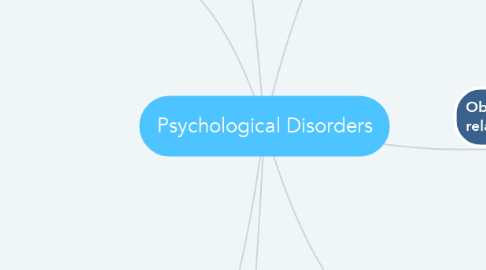
1. Trauma and stress disorder
1.1. Post-traumatic Stress disorder
1.1.1. Extremely stressful or traumatic events, such as combat, natural disasters, and terrorist attacks, place the people who experience them at an increased risk for developing psychological disorders
2. Mood disorders
2.1. Mood disorders are characterized by massive disruptions in mood.
2.1.1. Major depressive disorder
2.1.1.1. Symptoms include: – Depressed mood most of the day, nearly every day –loss of interest and pleasure in usual activities. –Feeling overwhelmingly sad most of each day. –No interest or enjoyment in activities
2.1.1.1.1. Types
2.1.1.2. To be diagnosed
2.1.1.2.1. Weight loss
2.1.1.2.2. Difficulty falling asleep
2.1.1.2.3. Psychomotor agitation
2.1.1.2.4. Fatigue
2.1.1.2.5. Guilty
2.1.1.2.6. Difficulty concentrating
2.1.2. Bipolar disorder
2.1.2.1. The person often experiences mood states that vacillate between depression and mania
2.1.2.1.1. Symptoms
2.1.2.2. Manic episode: distinct period of abnormally and persistently elevated, expansive, or irritable mood and abnormally and persistently increased activity or energy lasting at least one week
3. Psychotic disorder
3.1. Schizophrenia
3.1.1. the person’s thoughts, perceptions, and behaviors are impaired to the point where he/she is not able to function normally in life
3.1.1.1. Symptoms
3.1.1.1.1. Hallucination: a perceptual experience that occurs in the absence of external stimulation. Delusions: beliefs that are contrary to reality and are firmly held even in the face of contradictory evidence Disorganized thinking: incoherent thought processes. Disorganized or abnormal motor behavior: unusual behaviors and movements (very active or catatonic). Negative symptoms: noticeable decreases and absences in certain behaviors, emotions, or drives.
3.1.1.2. Causes
3.1.1.2.1. Both genetic vulnerability and environmental stress are necessary for schizophrenia to develop. •Obstetric complications. (That affect brain development) •Another variable that is linked to schizophrenia is marijuana use.
4. Personality disorders
4.1. People with personality disorders exhibit a personality style that differs markedly from the expectations of their culture, is pervasive and inflexible, begins in adolescence or early adulthood, and causes distress or impairment
4.1.1. Cluster 1
4.1.1.1. People with these disorders display a personality style that is odd or eccentric
4.1.1.1.1. Paranoid
4.1.1.1.2. Schizoid
4.1.1.1.3. Schizotypal
4.1.2. Cluster 2
4.1.2.1. People with these disorders usually are impulsive, overly dramatic, highly emotional, and erratic
4.1.2.1.1. Antisocial
4.1.2.1.2. Histrionic
4.1.2.1.3. Narcissistic
4.1.2.1.4. Borderline
4.1.3. Cluster 3
4.1.3.1. People with these disorders often appear to be nervous and fearful.
4.1.3.1.1. Avoidant
4.1.3.1.2. Dependent
4.1.3.1.3. Obsessive Compulsive
5. Anxiety Disorders
5.1. Most frequent occurring class of mental disorders and are often combined with each other and other mental disorders
5.1.1. Phobias
5.1.1.1. Intense, unreasonable and persistent fear caused by a specific object or situation
5.1.1.1.1. Most common phobias: Arcanophobia, aerofobia, claustrophobia
5.1.2. Social anxiety disorder
5.1.2.1. Extreme and persistent fear of social situations in which a person could be evaluated negatively
5.1.3. Panic disorder
5.1.3.1. You develop panic episodes where you sweat, tremble, want to puke and get dizzy
5.1.4. Generalized anxiety disorder
5.1.4.1. Continuous state of excessive, uncontrollable and pointless worry and aprehensión. You worry about routine and everyday life
6. Obsessive compulsive and related disorders
6.1. These disorders elevate the unwanted thoughts and repetitive behaviors intensely
6.1.1. Obsessive-compulsive disorder
6.1.1.1. Experience thoughts and urges that are intrusive and unwanted and feel the need to engage in repetitive behaviors
6.1.2. Body dysmorphic disorder
6.1.2.1. The person is preoccupied with a perceived flaw that is nonexistent or barely noticeable to others
6.1.2.1.1. The person does the following acts: constantly looking in a mirror, comparison with others, hiding said body part, etc.
6.1.3. Hoarding disorder
6.1.3.1. Cannot get ride of personal possessions regardless of how valueless or useless they are
7. Dissociative disorders
7.1. Characterized by an individual becoming split off, or dissociated, from her core sense of self
7.1.1. Dissociative amnesias
7.1.2. Depersonalization
7.1.2.1. The person believes his/her movements, thoughts and feelings are not their own
7.1.3. Derealization
7.1.3.1. The person feels that the world surrounding them is not real
7.1.4. DID
7.1.4.1. People with dissociative identity disorder exhibit two or more separate personalities or identities, each well-defined and distinct from one another
7.1.4.1.1. Causes
